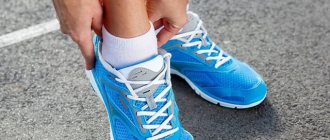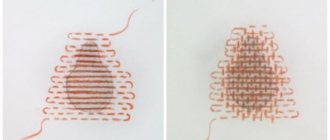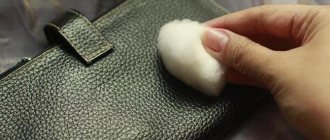If the donated jeans turned out to be too big, or your favorite ones began to hang loose, this is not a reason to be upset. In most cases, you can reduce jeans by one or even two sizes yourself, without resorting to the services of a tailor.
There are two main ways to solve the problem:
- perform moisture-thermal shrinkage of the product;
- sew jeans.
The choice of method depends on the type of fabric, model of trousers and how much you want to reduce them. If the pants are a little too big, you can get by with a simple shrinking procedure, but this method is not suitable for all types of jeans. Large differences in size can only be corrected using a sewing machine.
Is it possible to seat a certain area
It is very difficult for those with a non-standard figure to choose jeans with an ideal fit. The method of shrinking in certain areas (waist, hips, knees) will help solve the problem.
The following manipulations will help you reduce jeans to the required size in the desired area and adjust the cut to your figure:
- dilute fabric softener with water. Place the resulting mixture in a spray bottle;
- carefully spray the resulting mixture onto the part of the trousers that requires correction;
- place the jeans in the washing machine and turn on the washing mode at the maximum degree (95 C);
- Gins must be dried in a dryer or on a radiator;
- trousers shrink only if they are dried by force. Naturally, in the fresh air, the fabric only loses moisture, while the fibers remain unchanged.
By strictly following the instructions on how to reduce your jeans size, you can quickly get the desired result and continue to enjoy the perfect look of your trousers.
Existing methods
Denim naturally stretches. Several effective ways will help you reduce stretched trousers without ruining them.
Suturing
You can quickly, efficiently, and without wasting time and effort to reduce jeans at the waist (hips) if you give the item to a specialist for sewing. For those who want to reduce the size of jeans at home, you need to remember: jeans are a very dense fabric, and not every sewing machine can handle it.
You can sew up jeans yourself under certain conditions:
- availability of sewing skills;
- The denim fabric of the trousers is quite thin and does not stretch (there is no stretch effect);
- There is no decorative trim or complex fittings on the jeans.
If you decide to remake it yourself, follow a certain sequence of actions:
- determine how many centimeters and where exactly needs to be removed. It is more convenient to sew jeans in at the hips or waist along the side seam;
- carefully support the belt in the marked place;
- mark a new seam line and pin the fabric along it;
- sew a new seam;
- cut off excess fabric and trim the edges of the jeans;
- sew the belt in place;
- iron new seams using steam mode.
Hard and aggressive wash
Stretched jeans can be restored to their original shape and reduced by one size using the proven method of exposure to high temperatures. Simply put, in order for the trousers to shrink a little, they must be washed at a temperature above 60 C.
Washing as usual helps restore the trousers to their original appearance and remove stretched knees. But during wear, jeans stretch very quickly, and with each subsequent wash, the fabric quickly loses its ability to shrink.
There is a secret to getting your jeans to retain their shrink effect longer: the higher the wash temperature, the more pronounced the results will be.
When washing jeans at a temperature of 95 C, a rapid transformation of the fibers occurs, they narrow very much, while maintaining their shape. It is good if after washing the jeans are dried in the dryer. When this is not possible, the item is twisted in a centrifuge and dried on a radiator or on a flat surface in direct sunlight.
Before hard washing, you need to make sure that the denim does not contain synthetic threads, otherwise the end result may surprise you. The pants will become deformed and will forever lose their shape and fit. Also, jeans can be reduced in size by hard and aggressive washing only if they have stretched both in volume and length. Otherwise, there is a risk of putting trousers in the machine and then taking out short breeches.
Boiling
An effective method that will quickly reduce the size of denim trousers is boiling.
Algorithm of actions:
- Prepare a solution of washing powder and hot water. There is no need to purchase expensive washing powder for these purposes. The price does not affect the quality of jeans size reduction;
- place denim trousers in the prepared solution. Be careful, excessively hot water can cause burns on your hands;
- Bring the soap solution with the jeans to a boil. For cooking, it is good to use a metal basin, bucket or very large container. The trousers must be boiled for at least half an hour for them to shrink. It is necessary to ensure that during the boiling process the fabric is completely immersed in water. Otherwise, denim pants will shrink unevenly;
- After boiling, the soap solution is allowed to cool. Denim trousers are thoroughly rinsed, wrung out and dried.
To avoid the appearance of yellow stains, it is better to dry light jeans in a dryer rather than on a radiator. The boiling process is guaranteed to reduce denim pants by one size.
Swimming with clothes on
A non-standard but effective method for reducing jeans size is bathing in clothes.
The method is quite simple:
- Pull up your pants and fasten all the buttons and zippers. This is a very important point, since in smaller size jeans the fabric fits very tightly around the hips and waist, and unfastened fittings can cause distortion;
- It is better to narrow jeans using this method on the day (maximum two days before) of going out. When the trousers have already taken the required shape and parameters, you cannot wash them, as the fabric will stretch and all efforts will come to naught;
- fill the bathtub with hot water. The temperature should be as high as can be tolerated. Before getting into the bath, check the temperature of the water with your hand. Immerse yourself in the bath carefully, with smooth movements. The body must be covered to the waist. It is necessary to stay in the bathroom until the water reaches room temperature. If the water is too hot, it is better to wait ten minutes. It is necessary to ensure that the jeans are completely covered with water. Add water if necessary;
- drying denim trousers. As soon as the water has cooled, you can leave the bath. You can't take off your jeans. They are dried in the fresh air until the fabric takes the desired shape.
Dries well outside on a warm day, in direct sunlight. Sit comfortably on a chair or chaise lounge. Never sit on a surface that can absorb moisture. It is necessary to turn over from time to time so that the jeans dry evenly. It will take two to three hours for the trousers to dry completely.
Steaming
The method of reducing denim trousers using an iron is good, but, unfortunately, it gives a short-term effect. However, steaming is the ideal method for your favorite stretch denim pants.
For this work you will need an iron with a steam function. The ideal option is a special steamer unit.
Steaming is the simultaneous exposure of fabric to high temperature and moisture. The fibers of the fabric are compressed and take on the desired shape. If it is necessary to narrow the jeans on the sides, iron the side seams. When denim trousers are too big in the hips, carefully steam the back seams from the waist to the waist.
Thanks to the steaming method, the fabric fibers are minimally damaged, and the length of the product and paint are preserved. Steaming, compared to other methods of reducing trousers, takes much less time. Steaming does not stretch the fabric, but gently smoothes it out. However, this method has a short-term effect. Already at the next exit, the manipulation to reduce jeans must be repeated.
Drying rules
To prevent jeans from stretching, they need to be dried properly. That's right, that means fast. The fact is that regular drying, which takes from 5 to 10 hours, only contributes to the stretching of the fabric - the fibers have time to become straight and recover. This does not happen during fast drying. To make your jeans dry quickly:
- hang them next to the radiator or stove, or in the sun;
- put a fabric under your jeans that will absorb excess moisture;
- Use a tumble dryer if possible.
Attention! Remember that each method that helps to shrink jeans changes not only the width of the waist and hips, but also the length of the legs.
When purchasing new pants, always try them on well.
If the material stretches a lot, it is better to take a jeans size smaller. Choose quality denim or gin. Be sure to follow the washing rules. You can also stretch your jeans after washing if they have shrunk too much at home using improvised methods.
What to do if your jeans don't fit
In addition to the problem of shrinkage, there is a second one – non-shrinkage. It doesn't get any easier in finding a real method to restore your favorite pair of jeans to their original condition. In any case, follow the manufacturer's washing recommendations.
In order to avoid the possibility of getting an already small size even larger or even smaller, they recommend:
- Choose a delicate wash.
- If the temperature on the tag is 40 degrees, you can lower it to 35.
- It is also important to regulate the end of the spinning process. For machine washing, do not specify a high number of revolutions. The optimal amount would be 500 - 700 revolutions. If there is any water left on the jeans, let it drain better while drying.
To prevent the item from stretching, it is recommended to choose a delicate washing cycle.
If you follow all the rules, you will have to think much less often about what to do if your jeans shrink treacherously after washing?
How to sew jeans in the hips
If the jeans are too big in the hips, then you can sew them in when the difference in volume does not exceed 4 cm. Otherwise, you will have to reshape the front part, and only an experienced seamstress can do this.
To narrow the product at the hips, you need:
- Hitch the waistband and open the back and side seams to the hip measurement.
- Sew according to the new measurements, observing the style of the old seams. Finishing stitches must be done carefully.
- Measure the belt to the desired length, trim off excess material and stitch to the trousers.
How to suture
When the jeans are too big and the fabric itself does not shrink, then the surest way to get rid of extra centimeters in the waist and hips is to sew them up.
In a workshop
Yes, this is the most professional advice. The master will take the correct measurements, cut where necessary, and sew the item so that it will not differ from the factory one. The only thing is that the cost will not be the lowest. If the jeans themselves are not expensive, or you simply don’t want to pay someone for a simple job, you can try not going to a workshop, but sewing them yourself.
See also
How to properly care for a shower stall at home and cleaning methods
How to alter it yourself
This is a labor-intensive process that requires certain skills, time and equipment.
What you will need for work:
- Sewing machine.
- Scissors.
- Tailor's pins.
- Threads.
- Overlock.
- Steamer.
- Chalk, pencil or piece of soap.
- Iron.
If you decide to alter your jeans yourself, you will need the items and tips listed above. First of all, you need to rip out the seams in problem areas. This can be done with simple scissors or use a steamer. This is a special tool with a sharp end that easily penetrates the stitching and removes threads. When everything is done, you need to remove the old threads and iron the parts with an iron. Next you need to take measurements. Remove extra centimeters on the parts. To do this, draw new markings with chalk or soap.
Next, you will have to sketch out a new version of the model. Do a fitting. If the jeans fit well, you can begin to secure the seams.
To prevent the cut edges from fraying, you need to process them with an overlocker . It is worth telling that the sewing options are different. There are different methods at work in the waist, hips or length.
Sign 5: The clasp sticks out wavy
It is worth paying attention not only to the legs, the waistline and the presence of folds. Lightning plays an important role. If it sticks out like a wave or protrudes, it means that you have chosen a model that is too large and you should pay attention to another copy. It is only at first glance that there is nothing wrong with such a feature. In fact, lightning can ruin your entire look.
Alternative methods for shrinking denim
- Reshaping. This radical method will be effective, but only if the work is done well. You should take on the job yourself only if you have a certificate of completion of cutting and sewing courses. In addition, you will need a professional sewing machine, since denim fabric can be very dense.
- Fit to size. Only models made of thin denim can be sewn in. But even such samples have dense plexuses, so it’s not easy to do the work yourself. In addition, it is worth understanding that it will not be possible to significantly change the size, otherwise the model will completely lose its appearance and creases will form. In most cases, the size is adjusted at the waist.
How to sew and narrow the legs of flared jeans, from straight to skinny
Nowadays, very tapered trousers are in trend, and flared and wide straight models are outdated. It is difficult to transform a wide flare into very narrow trousers. Different cuts do not lead to good results.
It is better to remove only 4-5 cm:
- Open up the gates.
- Place basting marks with pins on the wrong side of the outer and crotch seams.
- Draw seam lines.
- Trim excess fabric.
- Baste seams and try on pants.
- Sew the seams, overcast their edges.
You can use old tight pants with a good fit as patterns. The “correct” model is pinned onto wide trousers turned inside out, and then lines are drawn along its contours.
Flared trousers are tapered from the knees, and straight trousers are tapered along the entire length.
Advice from experienced craftsmen will help you avoid mistakes when sewing at home:
- Before starting work, wash, dry and iron the product.
- Do not rip a thick seam in the crotch area, as it will be difficult to sew up.
- Don't rush to cut off excess material.
- Don't save time on additional fittings.
- For denim, choose special threads or regular thick ones.
- Sew the connecting seams in two lines with tacks at the end.
- To tighten the finishing stitch, thread 2 threads of the same color into the upper needle.
- It is advisable to do the markings with pins together with an assistant.
- You should not take on the task of altering very large trousers. You will have to rip out all the seams and re-cut them according to other patterns.
How to seat in a certain place?
Fabric conditioner will help restore shape to jeans that have stretched knees, waistbands, or bulging pockets.
What should be done:
- dilute fabric softener with clean water in a ratio of 3:1;
- pour the resulting solution into a spray bottle and carefully treat the stretched areas of fabric on the jeans;
- We place wet jeans in the drum of an automatic dryer or quickly iron the dampened areas with an iron.
The shrinkage effect of denim can only be achieved by drying as quickly as possible. Using the traditional method of drying on a rope under the sun, it will not be possible to achieve the effect of fabric shrinkage.
Machine washable
Jeans have the same shrinkage after hand and machine washing. The easiest way to wash clothes is in a washing machine. However, this method is only suitable for clothes containing 70-100% cotton fibers.
How to use the washing machine:
- Set the temperature as high as possible (90-95°C)
- Set to high speed (800-1200)
- Load detergent
- Put your panties in the drum and start the technique
Do not wash other clothes with jeans. If you have a washer dryer, set it to the highest setting.
Avoid excessive use of the automatic sprinkler in high temperatures to prevent clothing from fading. If you do not want to shrink the fabric, use a gentle wash.
How to Shrink Jeans by Washing
Surely your jeans have shrunk at least once after an unsuccessful wash. If you approach the matter wisely, you can use this feature for good and return the shape of the old product. These methods, as mentioned above, are mainly suitable for denim with a low synthetic content (up to 10%). However, a cheap product with low-quality synthetic threads can also shrink from such procedures.
Machine washable
The easiest way to carry out the procedure is in a machine:
- Empty the drum and place only the jeans in it.
- Set the maximum water temperature (usually 90 degrees) and the maximum spin speed.
- Add fabric softener.
It will prevent the jeans from becoming excessively stiff (oaky) after shrinking. Washing powder or gel can also be added if desired. It will not prevent the product from shrinking. - Wash your jeans on the most intensive cycle.
- Remove the product and dry it horizontally.
If you don’t have a washing machine at hand, use boiling water. You will need large tongs for styling jeans and a pan in which the product fits completely:
- Boil water in a saucepan.
- Place the jeans in boiling water using tongs.
- Boil them for 20–30 minutes. The process must be monitored at least once every five minutes. Jeans will not be able to burn to the pan, but the gurgling water will periodically push them to the surface. Your task is to use tongs to immerse them back.
- Drain the water and wait for the jeans to cool slightly to avoid burning yourself. Be especially careful with metal parts (buttons and fly).
- Dry your jeans horizontally.
Features of denim fabrics
Jeans began their march around the planet in the middle of the 19th century as an item of clothing for a working man. Both pants and other products, shirts, jackets, were made of dense, coarse cotton, which gave maximum wear resistance and durability. Over time, jeans took over the world, moving into the category of casual wear. The global increase in importance is driven by developments that improve the appearance and functionality of fabrics.
The following types of denim fabrics are distinguished:
Denim. You will have to pay a decent amount for jeans made from real denim. But the price is worth it. They contain exclusively natural, high-quality raw materials. A distinctive feature is the color: blue on the front and white on the back. They are not afraid of high temperatures - washing up to 90 degrees is acceptable.
Jean. If you compare denim and gin, they are the exact opposite of each other. Gin is distinguished by its availability, which, unfortunately, comes with low quality. The coloring is identical for both sides. A special feature is considered to be imaginary shrinkage. Jeans washed in hot water visually shrink in both volume and length. In fact: the fabric will shrink only temporarily. One of the advantages, perhaps, is that along with the size, the softness lost during shrinkage will return.
Stretch. Skinny jeans that embrace every curve of the body with a gentle embrace are sewn from an elastic material called “stretch”. To obtain the existing result, according to the technology, elastic threads are added to coarse fabrics, such as denim. The result is an ideal symbiosis that gives a wonderful aesthetic appearance and a comfortable feeling when worn. The aesthetics of the product are undermined as soon as the jeans begin to stretch, which cannot be avoided with constant, intense wear. Hand washing using hot water and natural drying will correct the situation.
Chambray. Of all denim fabrics, chambry is characterized by its fragility: things made from the fabric wear out quickly and tear easily. After washing in hot water or boiling, they shrink significantly. This is due to the fact that the density of chambrie is much less than that of high-quality denim. But it is precisely this indicator that makes the fabric an ideal material for things for the summer.
The composition of the fabric gives jeans the ability to stretch and shrink. There are effective methods that can reduce the size.
How to tape your trousers at home
There is nothing difficult in creating such beauty. Open the bottom edge (hem). Iron the product. Try on the pants from the wrong side. Spin around the mirror. Mentally estimate how much it needs to be narrowed.
Adjustment on one side is made subject to slight narrowing. Then it looks more practical (internal or external). Is there any decor?
Mark excess material on the material with pins. You have to be careful here. This may affect stretch fabric. The fabric will stretch a little and the stitching will be crooked. If the fabric is non-stretchy, your legs should fit comfortably into the pant leg. The main thing is not to overdo it.
- Remove carefully and spread on the table.
- Align. Draw a line with chalk along the marked areas. Draw a 2nd line for the seam.
- Baste with threads along 1 line.
- Try it on again and check the comfort.
- Adjust as necessary.
- Trim off excess fabric.
- Seal the edges.
- Machine sew trousers.
Adjustments on both sides are made under the condition of large narrowing. The same actions are performed, only on both sides at an equal distance. Otherwise it will be crooked. Finish hem and iron.
Body types
It’s unfortunate, but ideal body proportions are found only in a small number of women - 10-15%. But that doesn't mean the rest of the female population is awkward. Any body type is unique in its own way and, in addition to its disadvantages, there are a number of advantages that make every girl beautiful.
The most important thing at the beginning of creating an image for overweight girls is to correctly determine the type of figure. This is not a complicated process; you just need to pass a special test, which is easy to find on the Internet, or by studying your own reflection and analyzing a number of parameters, determine your type yourself. To do this, you need to take a soft measuring ruler and write down the following parameters:
For convenience and accuracy of the result, the data is transferred to paper, marking one by one the required number of centimeters on a scale (10 cm real = 1 cm on the sheet).
As a result, the extreme points are connected to each other and the result obtained is evaluated.
Referring to the classic list of standards, you should compare the resulting pattern with a triangle, an apple, a rectangle, a pear and an hourglass.
Temperature difference
A contrast shower is not only good for your health, but also helps your jeans shrink. To make them sit down and stop stretching, you will need 2 bowls: one for cold water, the other for hot water. Transfer clean jeans from one container to another: first into cold water for a few minutes, then into boiling water for a couple of minutes. Repeat the procedure 5-7 times, then dry the product on a horizontal surface.
Advice! If you have time, you can leave the jeans in ice water all night, and in the morning rinse them in boiling water and dry them.
Tips for reducing your jeans size at home
Working on reducing your jeans size yourself will require perseverance and painstaking work. The experience of experienced craftswomen will help.
Tips for sewing jeans:
- Carry out the work on a clean product that has already been worn. This way you will see how much the jeans stretch as you wear them.
- Take your time and don't rush! It is better to do an additional fitting to adjust the pants to your figure than to ruin the item.
- Do not rip the legs of your trousers completely, turning them into a skirt: not everyone can sew them correctly in the crotch area on their own.
- Use double stitching and extra stitches at the end of the seam to improve the quality of your work.
Perform all actions carefully and carefully, and you will succeed!
Boyfriend JeansPush Up Jeans
Useful tips
Reducing the size of jeans that are slightly stretched seems quite simple at first glance. But if you ignore the rules of washing and drying, you can ruin the item. For this reason, you should adhere to the following recommendations:
- When washed, boiled and dried, jeans become smaller not only in width, but also in length. Take this feature into account before putting the item in the washing machine, otherwise you will end up with an item that is unsuitable for wear.
- To reduce the size, you can only wash jeans in hot water that are made of cotton material (at least 70% cotton). Products made from lycra or synthetics may completely lose their shape when exposed to strong heat.
- You shouldn't wear jeans every day, even if they are your favorite. Let the item rest and it will stretch much more slowly.
Using these recommendations, you will keep your denim trousers in decent shape for a long time.











